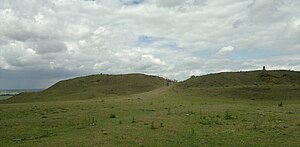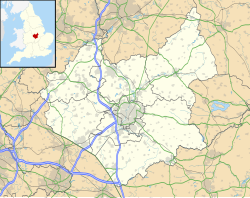Burrough Hill
| Burrough Hill | |
|---|---|
| Burrough on the Hill, Leicestershire | |

The main entrance to the hillfort
|
|
| Coordinates |
52°41′59″N 0°52′32″W / 52.699754°N 0.875517°WCoordinates: 52°41′59″N 0°52′32″W / 52.699754°N 0.875517°W grid reference SK76081193 |
| Type | Iron Age hillfort |
| Site information | |
| Owner | Ernest Cook Trust |
| Controlled by | English Heritage |
| Condition | Earthwork remains |
Burrough Hill is an Iron Age hillfort in Burrough on the Hill, 7 miles (11 km) south of Melton Mowbray in the English county of Leicestershire. Situated on a promontory about 210 metres (690 ft) above sea level, the site commands views over the surrounding countryside for miles around. There has been human activity in the area since at least the Mesolithic, and the hillfort was founded in the early Iron Age. In the medieval period, after the hillfort was abandoned, the hill was used as farmland. This ended in the 17th century when the parish the hill was in was enclosed. Traces of ridge and furrow show where the medieval fields were ploughed. Since the 1930s the site has been the subject of archaeological investigations and renewed excavations under the auspices of the University of Leicester began in 2010. Part of Burrough Hill Country Park and open to the public, the hillfort is protected as a Scheduled Ancient Monument.
Hill forts developed in the Late Bronze and Early Iron Age, roughly the start of the first millennium BC. Their purpose and the reason for their emergence in Britain has been the subject of debate. It has been argued that they could have been military sites constructed in response to invasion from continental Europe, sites built by invaders, or a military reaction to social tensions caused by an increasing population and consequent pressure on agriculture. The dominant view since the 1960s has been that the increasing use of iron led to social changes in Britain. Deposits of iron ore were located in different places from the tin and copper ore necessary to make bronze. There were new centres of production and trading patterns shifted, allowing a new social elite to emerge and power passed into the hands of a new group of people. Archaeologist Barry Cunliffe believes that population increase still played a role and has stated that hillforts
provided defensive possibilities for the community at those times when the stress [of an increasing population] burst out into open warfare. But I wouldn't see them as having been built because there was a state of war. They would be functional as defensive strongholds when there were tensions and undoubtedly some of them were attacked and destroyed, but this was not the only, or even the most significant, factor in their construction.
...
Wikipedia

